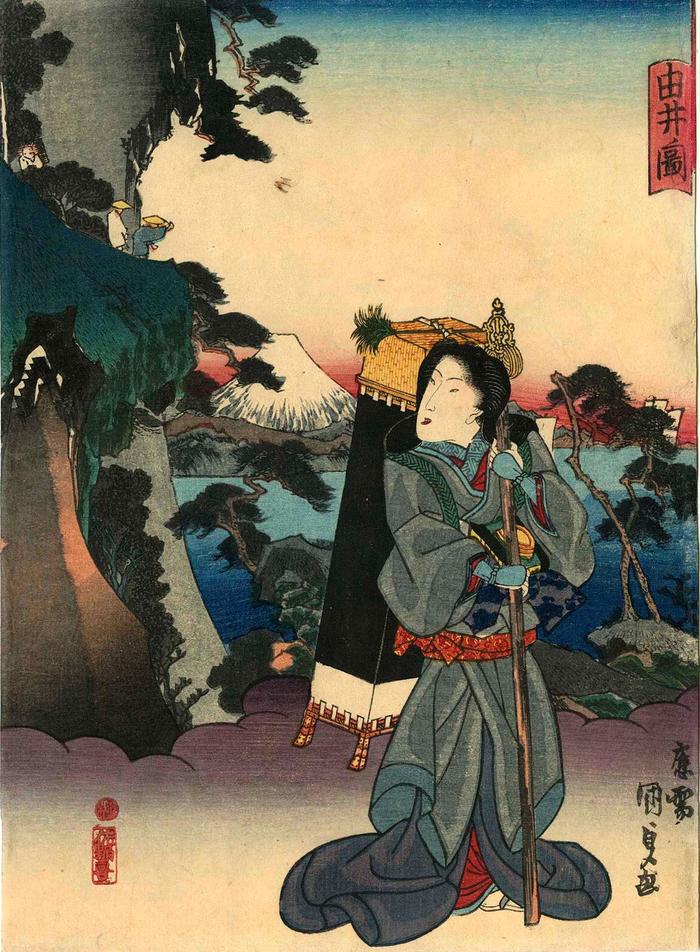Utagawa Kunisada (歌川国貞) / Toyokuni III (三代豊国) (artist 1786 – 01/12/1865)
View of Yui (Yui no zu: 由井之図) from the series Fifty-three Stations of the Tōkaidō Road (Tōkaidō gojūsan tsugi no uchi: 東海道五十三次之内)
ca 1838
Signed: ōju Kunisada ga (応需国貞画)
Publisher: Sanoy Kihei
Censor's seal: kiwame
National Diet Library
Museum of Fine Arts, Boston - published by Moriya Jihei
Library of Congress
Minneapolis Museum of Art
Museum für angewandte Kunst, Vienna
Museum of Fine Arts, Boston - Hiroshige's version
Ishikawa Prefectural Museum of Art - they date their copy to 1836
Bryn Mawr
Honolulu Museum of Art - published by Moriya Jihei
Los Angeles County Museum of Art
Fujisawa Ukiyo-e Museum
Victoria and Albert Museum
Nelson-Atkins Museum of Art All of the prints in this series are chūban sized. The example of this print in the collection of the Museum of Fine Arts in Boston is 9 3/8 × 7 5/16 in. This one in the Lyon Collection is fractionally smaller because it has been trimmed somewhat on both right and left sides.
****
In Hokusai and Hiroshige: Great Japanese Prints from the James A. Michener Collection, Honolulu Academy of Arts on page 180 it says:
"A little more than 2 miles from Kambara, steep mountains pushed the road toward the sea until it disappeared into the waves that lapped the foot of the cliff. Until the middle of the seventeenth century, travelers waited there for low tide, so they could walk around this obstacle. In 1655, in preparation for receiving members of a Korean mission, who were to travel to Edo, the Edo government cut a road into the mountainside here, the Satta Pass.
Hiroshige depicts the cliff of the pass at left and the strikingly beautiful Kiyomi Bay and its sailboats at eh right. Snow-covered Mount Fuji rises near the center. Atop the cliff, two fearful travelers look toward the bay; one of them clings to the rocky face of the cliff. At this point, travelers leave the town of Yui and the sight of Fuji behind as they continue toward Edo, though the mountain can still be glimpsed."
****
This is number 17 in the series.
The Museum für angewandte Kunst in Vienna says of this print: "In the foreground a woman dressed in the manner of a wandering monk. She has a Buddhist altar on her back and a monk's staff in her hand. The robe has gathered her up and tied it with a sash."
Gian Carlo Calza in his description in Hiroshige: The Master of Nature of the original Hiroshige print re-imagined in this scene said: "This print is considered to be one of the most beautiful landscapes in the entire series. The Satta Pass road - we see travellers on it in the upper left - was built in the late seventeenth century to receive a diplomatic mission from Korea. While a mountain man climbs toward the pass with an enormous bundle of wood on his back, two wayfarers have stopped to contemplate the spectacle of nature. One leans forward, shading his eyes with his right hand while steadying himself with his left. His companion, one step behind, appears to hold out his arm to assist him. Before them spreads the breathtaking Kiyomigata, "limpid view of the lagoon", with sails in the wind on the blue water and Mount Fuji towering over the brown hills to the left. But perhaps most enthralling is the foreground with the pine trees sculpted harshly by the wind and the elements: tall, stark and bent with a precise rhythm that brings them into kinship with the broken and tilting rocks. It is an exquisite interpretation of the "literati style'."
****
In Tokaido Landscapes: The Path from Hiroshige to Contemporary Artists, 2011, #17, p. 29, speaking of the original Hiroshige print it says in a text by Sasaki Moritoshi: "Satta Peak, which was usually called Satta Pass, was famous for its superb view of Mount Fuji to the east."
****
In Hiroshige: l'art du voyage, Paris, 2012, p. 69 it says that the water can be identified as the Bay of Suruga (駿河湾) and that Miho can be seen in the distance.
****
In Masterworks of Ukiyo-e: Hiroshige, the 53 Stations of the Tōkaidō by Muneshige Narazaki. 1969, p. 45 it says: "The countryside hereabouts has always been considered among the most beautiful on the Tōkaidō, and even today, from the windows of a swift-moving train, makes a lasting impression on the traveler. In the earliest days, travelers had to get around the cliff at the risk of their lives. Then, in 1655, a road was cut through and was called the Satta Pass. Even so, judging by the way the two travelers are holding onto each other and to the rock, it was not the safest passage in the world. But the view, with Mount Fuji in the background and white sails dotting the blue waters of the Bay of Kiyomi, was considered worth the risk."
****
Illustrated in a small color reproduction in Kunisada's Tokaido: Riddles in Japanese Woodblock Prints by Andreas Marks, Hotei Publishing, 2013, page 66, T24-17.
Sanoya Kihei (佐野屋喜兵衛) (publisher)
landscape prints (fūkeiga 風景画) (genre)
beautiful woman picture (bijin-ga - 美人画) (genre)
